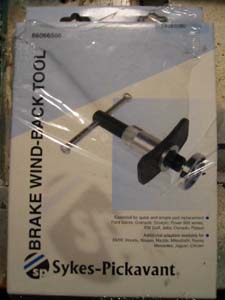

Changing Rear Brake Pads
I strongly recommend buying a Sykes Pickavant brake caliper wind back tool, part number 66066500. They're about £20 from Halfords and have a lugs on the plate for winding back the rear piston and so the handbrake. I did my rear pads on my 155 and had the same problem until I bought this took and then it took seconds!

It's one of those tools I wish I'd bought years ago as it saves you having to get out the G clamps and blocks of wood!! It doesn't say anything about Alfa fitment on it, but I managed to get it to work on mine for the rears.
I suppose you could make one if you had a welder and a g-clamp. You would just need to weld a bar to the foot of the clamp that has two holes drilled through each end and a small nut and bolt. The two bolts need to be spaced apart slightly less than the diameter of the piston as these will wind back the piston whilst the pressure from the gclamp pushes it back in. I've drawn a diagram of the proposed tool which you can click on to enlarge.
Hope this helps with the rear brake pad changing scenario. Whilst you're at it, maybe try and lucricate your handbrake cables / check the rubber boot that stops water getting in as they'll freeze solid in winter!!
Henry Yorke
Here was a post on the Alfa 155.com forum from Chris Curtis on 4th July 2001
Apart from slightly
less room to work in the rear brakes are pretty much the same as the front.
The callipers were held on by 16mm bolts instead of the 17mm at the front and
I mention this as not all spanner sets will have a 16mm piece in them. As it
happens, both sides were exceptionally tight and needed a socket to get them
loose anyway.
Two locator screws hold the disc in place and these are the same size as those
on the front. One of them was badly rounded and looked difficult to remove with
a spanner (they are very easy to round off if over-tight). Instead of trying
I used a small metal vice to clamp it and to start the loosening procedure.
I find a metal vice is incredibly useful in these situations - they are like
mole grips only much better.
The handbrake cable does not need to be removed although it is easy to do this
if you wish. Whilst there, why not check that the rubber boots on the end of
the cable are OK and stopped up with high temp grease to prevent that frozen
handbrake problem in the winter.
The calliper pistons require screwing back to open the calliper up enough for
the new pads. This involves turning the piston clockwise and applying pressure
at the same time. It was easiest to do this after temporarily reattaching the
calliper (without the brake disc). There is a special tool to screw the piston
back (£20 from Halfords - thanks Henry) but I didn`t need it. Using a
22mm spanner, or whatever size you have that is sized ok for you, fit the tips
of the open end into the cross shape on the end of the piston. Put a rod from
the socket set/screwdriver/other spanner/whatever through the ring or other
end of the spanner and use it to turn. Quite easy as you only need about 10
turns to get the piston from right out to right in. I did find that the piston
will only go in so far and then stop. This was very frustrating but I eventually
found that you need to loosen the bleed nipple before it will continue. I guess
the backflow return restrictor in the ABS was preventing the fluid getting back
up the pipes and there was too much pressure build up. Whatever it was, loosiening
the bleed nipple is an essential or you will pull all of your hair out!
The pads are a bit fiddly as the spring on them is quite strong, but nothing
too bad.
After a quick bleed of the brake in case of air getting in I just put it all
back together. I recommend putting the calliper onto the disc before refitting
the disc and calliper properly as its very hard to fit the calliper with new
pads after the disc is on.